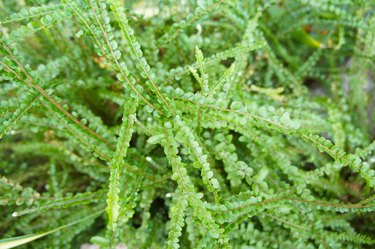
Button-shaped leaves with a slight lemon scent given lemon button fern (Nephrolepis cordifolia 'Duffii') its name. Also called button sword fern or erect sword fern, lemon button fern is a frost-tender perennial that's usually grown as a beautiful houseplant, but it also grows outdoors year round in U.S. Department of Agriculture plant hardiness zones 10 through 11. Reaching 1 foot tall and wide, this moisture-loving plant needs regular fertilizer.
Video of the Day
A lemon button fern grows best with regular fertilizer. Use a balanced fertilizer, which has equal amounts of the major plant nutrients, such as a 20-20-20 fertilizer applied at half-strength. Fertilize indoor and outdoor lemon button ferns when they're actively growing.
Video of the Day
Use a weak fertilizer solution to replace water for an indoor plant, such as 1 teaspoon per 1 gallon of water, or according to product-specific label directions. Use the same formulation for an outdoor lemon button fern and apply the solution once every two weeks. You can apply fertilizer solution to an outdoor plant in place of water if the plant needs watering. Manufacturer instructions vary among products, so read the plant label before mixing and applying fertilizers.
Providing Moist Conditions
Moist conditions are the secret to growing a lemon button fern successfully. Water indoor and outdoor plants when the soil surface is dry, but never apply so much water the soil becomes saturated. Pour water over the potting soil's surface until it flows through the drainage holes, and allow the plant to drain thoroughly before putting it back on its drip tray. Only use a container that has drainage holes.
To create humid conditions around your indoor lemon button fern, fill a shallow tray with sand, gravel or pebbles, and stand the fern in its container on the tray. Add water to the tray. As the water evaporates, it increases the humidity in the air around the plant. Add more water to the tray whenever it dries out, making sure that the water level always stays below the bottom of the pot.
Pruning the Plant
Mature leaves on indoor and outdoor lemon button ferns naturally die back in fall and winter, and pruning the dead leaves keeps the plant looking tidy. When new leaves appear in spring, sterilize your pruning shears by wiping the blades with rubbing alcohol, and prune brown, withered leaves at their bases where they join the rest of the plant. Lemon button fern foliage is crowded at the base of the clump, so take care not to prune green or emerging leaves. Sterilize the pruning shear blades again when you've finished pruning your fern.
Low temperatures damage a lemon button fern and could kill it. Outdoor plants don't survive winter in areas below USDA zone 10, and indoor plants don't grow well in temperatures lower than 60 degrees Fahrenheit. If your lemon button fern houseplant is on a windowsill, move it into the room at night and on cold winter nights to avoid the risk of chilling the plant. You can also place a sheet of thin cardboard or a few sheets of paper between the plant and the window glass to protect it from low temperatures. Lemon button ferns rarely suffer from serious pests or disease problems.